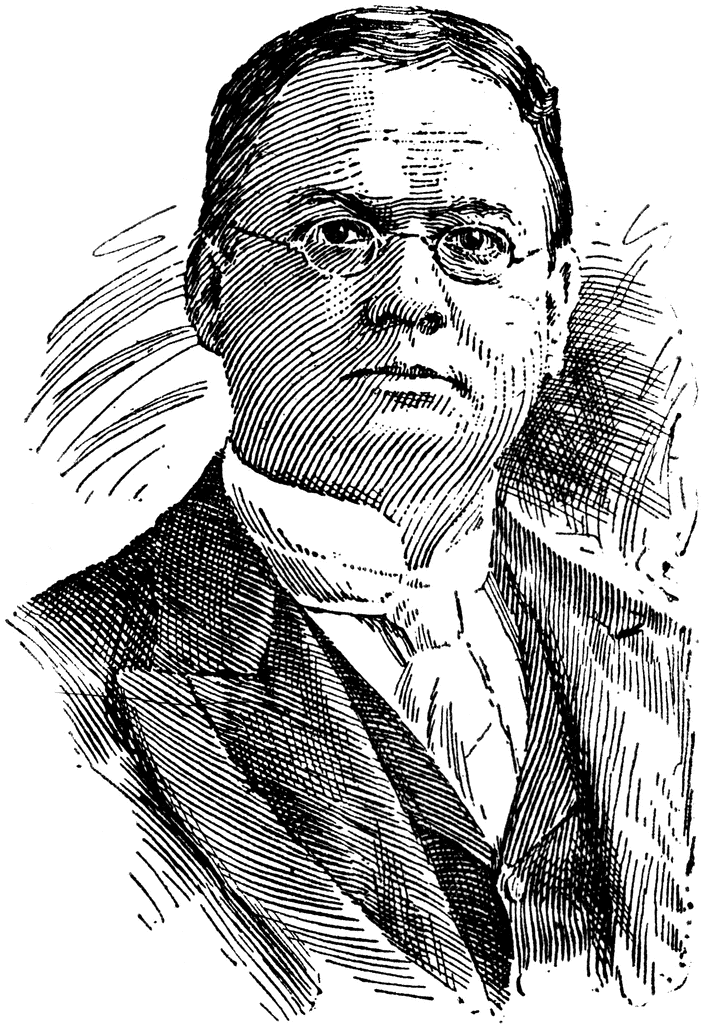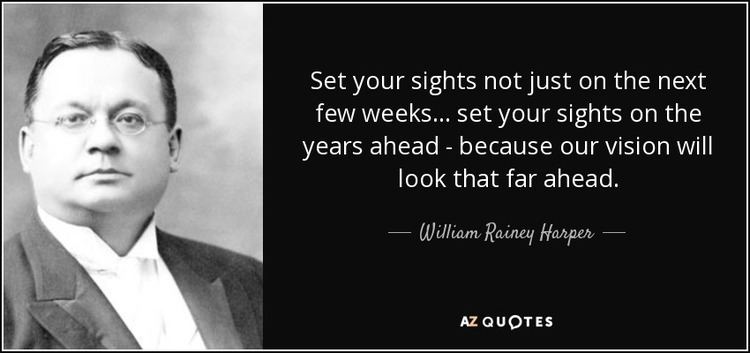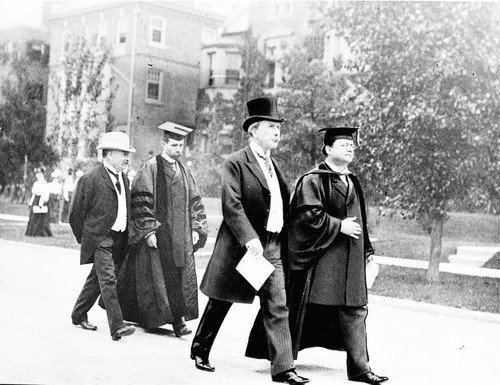Spouse(s) Ella Paul Harper Name William Harper | ||
 | ||
Born July 24, 1856New Concord, Ohio ( 1856-07-24 ) Children Samuel, Paul, Donald, and Davida Harper Alma mater Muskingum CollegeYale University Profession Scholar and educational administrator Died January 10, 1906, Chicago, Illinois, United States Books Amos and Hosea, Elements of Hebrew by an ind, Constructive Studies in the Priestl, William R Harper's Elements, The trend in higher education Similar People John D Rockefeller, John Dewey, Barack Obama, John D Rockefeller - Jr, Lester Crown | ||
young man in a hurry william rainey harper and harper college
William Rainey Harper (July 24, 1856 – January 10, 1906) was an American academic leader of the late 19th and early 20th centuries. Harper helped to establish both the University of Chicago and Bradley University and served as the first president of both institutions.
Contents
- young man in a hurry william rainey harper and harper college
- Item 263 william rainey harper mummy puncher
- Early life
- Personal life
- As University of Chicago president
- Academic innovations
- Religious education
- Other activities
- Death and legacy
- Published works
- References

Item 263 william rainey harper mummy puncher
Early life
Harper was born on July 24, 1856, in New Concord, Ohio1, to parents of Irish-Scottish ancestry. Very early in his life, Harper displayed skills years ahead of other children of his age, and he was labeled a child prodigy. By the age of eight, Harper began preparing for college-level courses. At the age of ten he enrolled in Muskingum College in his native New Concord, Ohio. At the age of fourteen, he graduated from Muskingum College. In 1872, Harper enrolled in Yale University to begin his postgraduate studies, and he completed these in 1876. Harper quickly assumed a series of faculty positions, including ones at Denison University and Yale University. Throughout his academic life, Harper wrote numerous textbooks. A strong supporter of lifelong learning, Harper was also involved with the Chautauqua Institution in Chautauqua, New York, and its academic programs starting in 1883.
Personal life

William Rainey Harper married Ella Paul Harper in 1875. They were the parents of three sons, Samuel Northrup, Paul, and Donald, and one daughter, Davida.
As University of Chicago president

In 1891, John D. Rockefeller selected thirty-five-year-old Harper to assist in organizing the University of Chicago, and shortly thereafter, he was selected as the university's first president. Harper also had expert knowledge of every department of education as well as business acumen, and he was a very powerful public speaker. In hiring the faculty of the new university and selecting its students, Harper set standards quite high. Harper elevated the salaries of the faculty members above those of ordinary schoolteachers, and by doing so attracted the best scholars of all disciplines to the university.
Academic innovations
Harper founded the nation's first departments of Egyptology and sociology at Chicago and established the University of Chicago Press. He also instituted the nation's first extension school, enabling those who worked during the day to attend classes at night and on weekends. One of Harper's ideas, that many would benefit by taking the first two years of college in their hometowns, led to the founding of American community colleges.
In the 1890s, Harper, fearful that the vast resources of the University of Chicago would injure smaller schools by drawing away good students, established an affiliation program with several regional colleges and universities, including Des Moines College, Kalamazoo College, Butler College, and Stetson University. Under the terms of the affiliation, the schools were required to have courses of study comparable to those at the University of Chicago; to notify the University early of any contemplated faculty appointments or dismissals; to make no faculty appointment without the University of Chicago's approval; and to send copies of examinations to the University for suggestions and improvements prior to distribution. The University of Chicago agreed to confer a degree on any graduating senior from an affiliated school who made a grade of A for all four years and on any other graduate who took twelve weeks additional study at the University of Chicago. A student or faculty member of an affiliated school was entitled to free tuition at the University of Chicago, and Chicago students were eligible to attend an affiliated school on the same terms and receive credit for their work. The University of Chicago also agreed to provide affiliated schools with books and scientific apparatus and supplies at cost; to provide special instructors and lecturers without cost except travel expenses; and to provide a copy of every book and journal published by the University of Chicago Press to the libraries of the affiliated schools at no cost. The agreement provided that either party could terminate the affiliation on proper notice. Several University of Chicago professors disliked the program, as it required uncompensated additional labor from them and cheapened Chicago's academic reputation. After Harper's death in 1906, the program was gradually discontinued, and it had passed into history by 1910.
Religious education
With his background as a Semiticist and Baptist clergyman, Harper believed that the University's programs should include religious study. Accordingly, he arranged for the Baptist Theological Union Seminary to relocate from Morgan Park and become the University of Chicago Divinity School.
In 1903 Harper founded the Religious Education Association.
Other activities
While at University of Chicago, Harper chaired a mayoral commission responsible for reorganizing Chicago Public Schools and standardizing the system's curriculum. Harper, being opposed to the employment of women as teachers (which had resulted from the reforms of Horace Mann), moved to block a raise for female teachers and encourage the selective hiring of men. The ensuing dispute contributed to the organizing of the Chicago Teachers Federation, the precursor to the Chicago Teachers Union.
In 1896, Harper assisted Lydia Moss Bradley in founding Bradley Polytechnic Institute in Peoria, Illinois. Now known as Bradley University, Harper served as its first president.
Death and legacy
Harper died on January 10, 1906, of cancer at age 49. He and his wife are interred at Rockefeller Memorial Chapel on campus at the University of Chicago.
William Rainey Harper College, a community college located in Palatine, Illinois, honors him. He is also the namesake of Harper High School and Harper Avenue in Chicago. A former elementary school in Cleveland is named for him as well.
